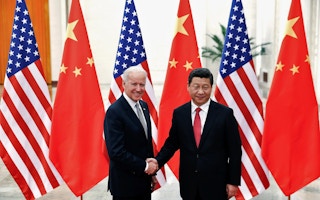November’s APEC summit in San Francisco comes at a crucial time.
Not only do the leaders of the 21 member nations face rising challenges to keep their domestic economies in shape, but there is brewing turmoil in the region along with a growing list of global challenges in climate change, energy and security.
To address these challenges, a shift is required.
In San Francisco in November, it is tensions between the US and China that will likely put the greatest pressure on the forum.
But APEC can be an avenue for discussions on trade policies and regional economic integration that can help alleviate trade disputes and promote economic stability.
What has drastically transformed within APEC is the shift towards China’s Pacific century. Two damaging financial crises, the Asian financial crisis of 1997-98 and the Global Financial Crisis of 2008, dented the standing of APEC as an institution.
This left China to re-orient the narratives of cooperation and economic integration. Beijing projected itself to be the one to recognise the gravity of the crisis and to provide help, rendering APEC largely irrelevant or painting the American APEC as obsolete.
China’s burgeoning economic prowess and the US’s anxieties about its influence in the Pacific aggravated this.
The Asia-Pacific region is one of the most intricate and complex geographies on the planet. It encompasses the apex economies of the world, hosts the economies with the largest populations, has witnessed an intense rise in high-net-worth individuals and their wealth, and stands as the focal point of the fastest-ever regional economic integration.
“
APEC members wonder where superpower rivalry is heading as China and the US vie for influence which may not serve the real intent of the forum. The super-region like the Pacific rim holds promise and needs a significant re-look at how it operates.
However, the region suffers from fragile geopolitical relations. This means maintaining stability is one of the defining challenges.
In addition, with China’s rise there comes a risk to the established liberal order as Beijing fosters an alternative way of doing things. Its presence is more visible in altering international trade and commerce. China not only exerts considerable control over the flow of goods and services but has also amplified its efforts to have its voice heard and to do things its way.
China’s economic slowdown has created other volatilities; it has become even more determined to exert its influence within APEC.
Its endeavours to revive the global economy with Chinese characteristics of ‘shared dreams’ and ‘common prosperity’, indicate Beijing is determined to pursue a ‘harmonious’ world order by positioning its interests above others.
China has been devising ways to expand its Belt and Road initiatives, which are now amplified into three grand global initiatives for ‘security, development and civilisation’.
China sees enormous economic and political benefits in rapidly transforming APEC and augmenting a new world order.
The US and China have substantial economic interests in the Asia-Pacific region, which hosts almost 40 percent of the world’s population and accounts for nearly half of global trade.
According to US government statistics, seven APEC countries are among its top 10 trading partners. The US exports 60 percent of its goods to the Asia-Pacific region. Similarly, the region accounts for more than 60 percent of China’s global trade and an even higher share of its foreign capital inflows in the region.
The region’s economic vitality is under strain from competition between various multilateral economic frameworks that have emerged in recent years.
APEC’s regional economic architecture is now entangled in geopolitical rivalries inflicted by newly created structures that merely offer utopian declarations for the developmental needs of the region, whether it’s the China-sponsored Regional Comprehensive Economic Partnership (RCEP) established in 2012 or the US-led Indo-Pacific Economic Framework (IPEF) founded in 2022.
The energy supply crisis and price shocks from Russia’s invasion of Ukraine have created multiple constraints for energy trade in the Asia-Pacific region.
With Europe’s access to Russian gas pipelines reduced significantly, it increased pressure on APEC’s major liquefied natural gas importing nations to meet domestic energy consumption demands.
The APEC region currently consumes 60 percent of the world’s energy, which will increase to 80 percent by 2050, given rapid industrialisation and urbanisation. This is likely to lead to even greater dependence on fossil fuels if clean energy alternatives are not found.
While the clean energy transition is critical for addressing climate change, geopolitical tensions may have an impact on clean energy cooperation.
For instance, the US-China rivalry affects the critical minerals supply chain in the Asia Pacific as China dominates the sector with 60 percent of worldwide production and 85 percent of processing capacity.
Consequently, with Australia’s lithium export capacity and Indonesia’s nickel production, the US seeks to build an alternative supply chain independent of China.
Supply chain vulnerabilities have reinforced the greater use of coal for energy production, affecting decarbonisation efforts in the Asia-Pacific region.
Security issues also linger. With Chinese revisionist tendencies ascending towards regional hegemony and the US efforts to contain it, the regional security architecture is now mostly influenced by the US-China rivalry.
Freedom of navigation in the South China Sea, Taiwan’s existence as an independent territory, and strategic manoeuvring in the Indian Ocean are all flashpoints.
Given the rise of China as a competitor on the high seas, the US has been forced to readjust its strategic partnerships with countries like India that are actively integrated into Western strategies, such as the Quadrilateral Alliance.
The US-China maritime rivalry is also manifested in significant new naval tonnage launched for the selected navies’ active in the Asia-Pacific, as China and the US are ranked 1 and 2 , respectively, since 2013.
As China claims regional and global hegemony and the US seeks to avert Chinese challenges to its hegemony, APEC will be an integral aspect of their claims of holding global leadership.
China and the US are both trying to develop trade ties which could hinder the prospects of APEC. Other APEC members are left with the question of global governance and accountability of the big powers towards developing and poor nations in the region.
APEC nations understand protectionism and unfair trade practices are neither helping the two powers nor the region. Amid performing feats of acrobatics to avoid antagonising China and the US, sub-regional and mini-lateral combinations of ties hold promise for the region.
The significantly smaller powers in APEC wish for a free Pacific Rim that pursues the economic benefits of integration.
APEC members wonder where superpower rivalry is heading as China and the US vie for influence which may not serve the real intent of the forum. The super-region like the Pacific rim holds promise and needs a significant re-look at how it operates.
Aravind Yelery, PhD is an Associate Professor at the Centre for East Asian studies in the School of International Studies at Jawaharlal Nehru University.
Originally published under Creative Commons by 360info™.


















